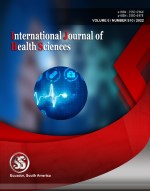Global sentiment analysis over third wave COVID19 tweets
Keywords:
data science, natural language processing, machine learning, prediction, COVID19, N-gramsAbstract
Internet users are increasing rapidly during the last decade, and after the Covid-19 outbreak, social media platforms became the favorite source to express public responses. They are using Twitter, a free microblogging site, to express their thoughts, joys, and sorrows spontaneously. Researchers take great interest in analyzing public sentiments with the help of Data science techniques like natural language processing and machine learning methods, to predict public suggestions on topics of social concerns. In the proposed research article, we have collected public tweets during the third wave of Covid19 from 21st to 31st January 2022, and public sentiments are observed with 12 popular Machine Learning algorithms and commonly used words are represented as n-grams and here three n-grams (Unigram, Bigram, and Trigram) are collected and prediction is also observed on these data. It is observed that in all the cases LinearSVC presents the highest classification accuracy of approx. 96% for covid datasets. It has also worked well on all the three n-gram datasets with accuracies of 96.39% for unigram, 95.24 for bigram, and 87.70% for trigram. data science
Downloads
References
A.S.M Kayes, M.S Islamm, P.A watter , A. Ng, and H. kayes. (n.d.). View of Automated measurement of attitudes towards social distancing using social media_ A COVID-19 case study _ First Monday. https://doi.org/https://doi.org/10.5210/fm.v25i11.10599
Aljameel, S. S., Alabbad, D. A., Alzahrani, N. A., Alqarni, S. M., Alamoudi, F. A., Babili, L. M., Aljaafary, S. K., & Alshamrani, F. M. (2021). A sentiment analysis approach to predict an individual’s awareness of the precautionary procedures to prevent covid-19 outbreaks in Saudi Arabia. International Journal of Environmental Research and Public Health, 18(1), 1–12. https://doi.org/10.3390/ijerph18010218
Aqlan, A. A. Q., Manjula, B., & Lakshman Naik, R. (2019). A study of sentiment analysis: Concepts, techniques, and challenges. In Lecture Notes on Data Engineering and Communications Technologies (Vol. 28). Springer Singapore. https://doi.org/10.1007/978-981-13-6459-4_16
Babu, M. S. P., & Katta, S. (2015). Artificial immune recognition systems in medical diagnosis. Proceedings of the IEEE International Conference on Software Engineering and Service Sciences, ICSESS, 2015-Novem, 1082–1087. https://doi.org/10.1109/ICSESS.2015.7339240
Barkur, G., Vibha, & Kamath, G. B. (2020). Sentiment analysis of nationwide lockdown due to COVID 19 outbreak: Evidence from India. Asian Journal of Psychiatry, 51(January). https://doi.org/10.1016/j.ajp.2020.102089
Chintalapudi, N., Battineni, G., & Amenta, F. (2021). Sentimental analysis of COVID-19 tweets using deep learning models. Infectious Disease Reports, 13(2), 329–339. https://doi.org/10.3390/IDR13020032
Dubey, A. D. (2020). Decoding the Twitter Sentiments towards the Leadership in the times of COVID-19: A Case of USA and India. SSRN Electronic Journal, April, 19–22. https://doi.org/10.2139/ssrn.3588623
Gupta, P., Kumar, S., Suman, R. R., & Kumar, V. (2021). Sentiment Analysis of Lockdown in India during COVID-19: A Case Study on Twitter. IEEE Transactions on Computational Social Systems, 8(4), 939–949. https://doi.org/10.1109/TCSS.2020.3042446
Hung, M., Lauren, E., Hon, E. S., Birmingham, W. C., Xu, J., Su, S., Hon, S. D., Park, J., Dang, P., & Lipsky, M. S. (2020). Social network analysis of COVID-19 sentiments: Application of artificial intelligence. Journal of Medical Internet Research, 22(8), 1–13. https://doi.org/10.2196/22590
Ikonomakis, E. K., Kotsiantis, S., Ikonomakis, M., Kotsiantis, S., & Tampakas, V. (n.d.). Text Classification Using Machine Learning Techniques EVOLUTIONARY INTELLIGENCE (SPRINGER): Special Issue on “Intelligent and Fuzzy Systems in Data Science and Big Data” View project Data preprocessing View project Text Classification Using Machine Learning Techniques. https://www.researchgate.net/publication/228084521
Kausar, M. A., Soosaimanickam, A., & Nasar, M. (2021). Public Sentiment Analysis on Twitter Data during COVID-19 Outbreak. International Journal of Advanced Computer Science and Applications, 12(2), 415–422. https://doi.org/10.14569/IJACSA.2021.0120252
Kwan, J. S. (2020). Understanding Public Sentiments , Opinions and Topics about COVID-19 using Twitter. June, 623–626. https://doi.org/10.1109/ASONAM49781.2020.9381384
Mansoor, M., Gurumurthy, K., U, A. R., & Prasad, V. R. B. (2020). Global Sentiment Analysis Of COVID-19 Tweets Over Time. October 2020. http://arxiv.org/abs/2010.14234
Maynard, D., & Funk, A. (2011). Automatic detection of political opinions in tweets. CEUR Workshop Proceedings, 718, 81–92.
Medford, R. J., Saleh, S. N., Sumarsono, A., Perl, T. M., & Lehmann, C. U. (2020). An “ Infodemic ”: Leveraging High -Volume Twitter Data to Understand Public Sentiment for the COVID-19 Outbreak.
Prakash, bishow. (2020). Twitter Sentiment analysis during COVID-19 Outbreak in Nepal Bishwo Prakash Pokharel M . Phil in ICT 3 rd semester Nepal Open University , Nepal Abstract Keywords. May 2020, 26.
Raza, H., Faizan, M., Hamza, A., Mushtaq, A., & Akhtar, N. (2019). Scientific Text Sentiment Analysis using Machine Learning Techniques. In IJACSA) International Journal of Advanced Computer Science and Applications (Vol. 10, Issue 12). www.ijacsa.thesai.org
Shelar, A., & Huang, C. Y. (2018). Sentiment analysis of twitter data. Proceedings - 2018 International Conference on Computational Science and Computational Intelligence, CSCI 2018, 1301–1302. https://doi.org/10.1109/CSCI46756.2018.00252
Singh, M., Jakhar, A. K., & Pandey, S. (2021). Sentiment analysis on the impact of coronavirus in social life using the BERT model. Social Network Analysis and Mining, 11(1), 1–11. https://doi.org/10.1007/s13278-021-00737-z
Published
How to Cite
Issue
Section
Copyright (c) 2022 International journal of health sciences

This work is licensed under a Creative Commons Attribution-NonCommercial-NoDerivatives 4.0 International License.
Articles published in the International Journal of Health Sciences (IJHS) are available under Creative Commons Attribution Non-Commercial No Derivatives Licence (CC BY-NC-ND 4.0). Authors retain copyright in their work and grant IJHS right of first publication under CC BY-NC-ND 4.0. Users have the right to read, download, copy, distribute, print, search, or link to the full texts of articles in this journal, and to use them for any other lawful purpose.
Articles published in IJHS can be copied, communicated and shared in their published form for non-commercial purposes provided full attribution is given to the author and the journal. Authors are able to enter into separate, additional contractual arrangements for the non-exclusive distribution of the journal's published version of the work (e.g., post it to an institutional repository or publish it in a book), with an acknowledgment of its initial publication in this journal.
This copyright notice applies to articles published in IJHS volumes 4 onwards. Please read about the copyright notices for previous volumes under Journal History.
















